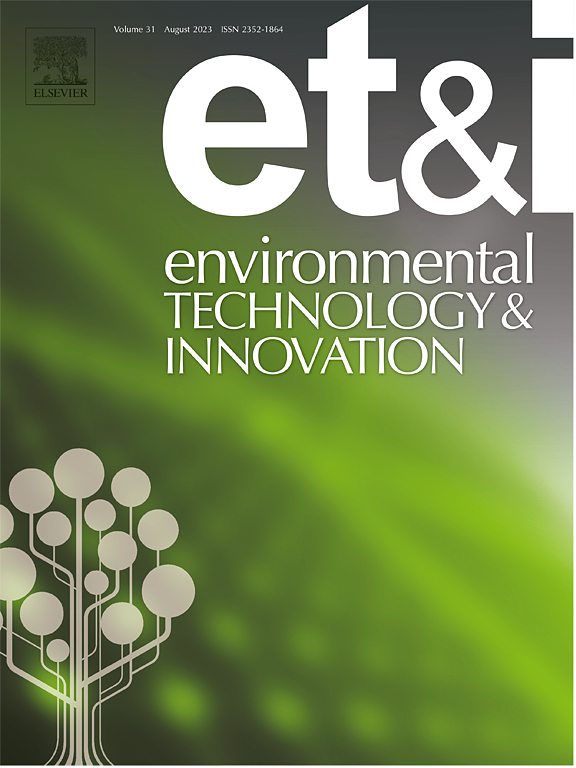Endophytic consortium exhibits varying effects in mitigating cadmium toxicity in rice cultivars with distinct cadmium accumulation capacities
IF 6.7
2区 环境科学与生态学
Q1 BIOTECHNOLOGY & APPLIED MICROBIOLOGY
引用次数: 0
Abstract
Cadmium (Cd)-contaminated rice is the main source of Cd exposure that threatens food safety and human health. While plant growth-promoting bacteria (PGPB) have been reported to reduce Cd toxicity in rice, the effect of endophytic consortium is less understood compared to the single strain. Here, we reported that the PGPB consortium consisting of Cd-tolerant endophytic bacteria Pseudomonas sp. 4N2 and Bacillus sp. TB1 increased extracellular polymeric substance secretion and demonstrated a higher Cd removal rate compared to individual 4N2 and TB1. Further, two rice cultivar, namely the low-Cd-accumulating (LA) cultivar 728B and the high-Cd-accumulating (HA) cultivar BB, were inoculated with the 4N2-TB1 consortium. As expected, the consortium had a more pronounced effect on 728B, from which the endophytic bacteria were screened. The 4N2-TB1 consortium was found to facilitate the growth of rice seedlings and enhance their antioxidation activity. Moreover, the consortium significantly reduced Cd transfer coefficient from root to shoot through Cd immobilization in rice roots, resulting in a reduction from 30 % to 6 % in 728B and from 31 % to 13 % in BB. Furthermore, alpha-diversity analysis indicated an increased diversity and richness of the root bacterial community after 4N2-TB1 inoculation. Also, redundancy analysis confirmed a positive correlation between rice biomass and Cd content with a specific assemblage of bacteria including Bacillus and Leifsonia. These results demonstrated that the 4N2-TB1 consortium may alleviate Cd stress in rice cultivars through recruiting PGPB and Cd-binding bacteria on the root surface, thus strengthening the immobilization of Cd in rice roots.
内生菌群在减轻具有不同镉积累能力的水稻栽培品种的镉毒性方面表现出不同效果
镉(Cd)污染的水稻是镉暴露的主要来源,威胁着食品安全和人类健康。虽然有报道称植物生长促进菌(PGPB)能降低水稻中的镉毒性,但与单一菌株相比,人们对内生菌群的作用了解较少。在此,我们报道了由耐镉内生细菌假单胞菌 4N2 和芽孢杆菌 TB1 组成的 PGPB 复合菌群与单个的 4N2 和 TB1 相比,增加了胞外聚合物质的分泌,并表现出更高的镉去除率。此外,4N2-TB1 复合菌群还接种了两种水稻栽培品种,即低镉积累(LA)栽培品种 728B 和高镉积累(HA)栽培品种 BB。不出所料,联合菌群对 728B 的影响更明显,内生菌就是从 728B 中筛选出来的。研究发现,4N2-TB1 菌群能促进水稻秧苗的生长,并增强其抗氧化活性。此外,联合菌群通过固定水稻根中的镉,大大降低了镉从根到芽的转移系数,在 728B 中从 30% 降至 6%,在 BB 中从 31% 降至 13%。此外,α-多样性分析表明,接种 4N2-TB1 后,根部细菌群落的多样性和丰富度有所提高。冗余分析还证实,水稻生物量和镉含量与特定的细菌群落(包括芽孢杆菌和雷弗森菌)呈正相关。这些结果表明,4N2-TB1 复合菌群可通过在根系表面招募 PGPB 和镉结合细菌来缓解水稻栽培品种的镉胁迫,从而加强水稻根系对镉的固定。
本文章由计算机程序翻译,如有差异,请以英文原文为准。
求助全文
约1分钟内获得全文
求助全文
来源期刊

Environmental Technology & Innovation
Environmental Science-General Environmental Science
CiteScore
14.00
自引率
4.20%
发文量
435
审稿时长
74 days
期刊介绍:
Environmental Technology & Innovation adopts a challenge-oriented approach to solutions by integrating natural sciences to promote a sustainable future. The journal aims to foster the creation and development of innovative products, technologies, and ideas that enhance the environment, with impacts across soil, air, water, and food in rural and urban areas.
As a platform for disseminating scientific evidence for environmental protection and sustainable development, the journal emphasizes fundamental science, methodologies, tools, techniques, and policy considerations. It emphasizes the importance of science and technology in environmental benefits, including smarter, cleaner technologies for environmental protection, more efficient resource processing methods, and the evidence supporting their effectiveness.
 求助内容:
求助内容: 应助结果提醒方式:
应助结果提醒方式:


